(14172 products available)


















































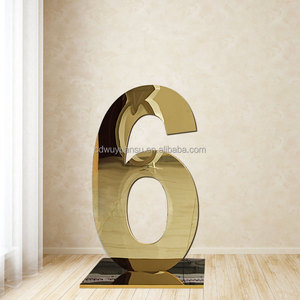
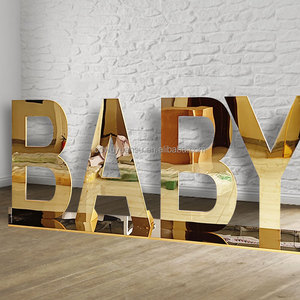
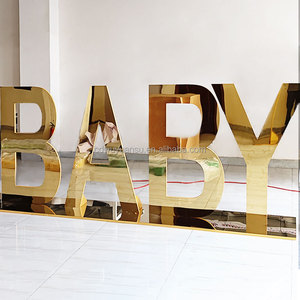
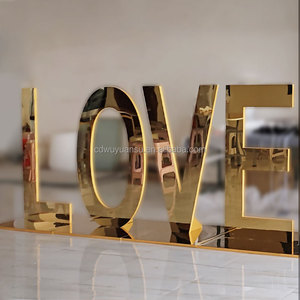
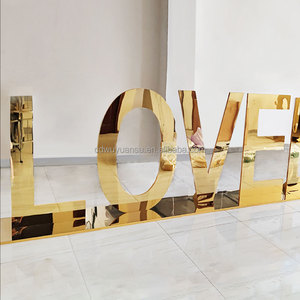



















































































































































































3D numbers and letters are used in various applications to enhance visual communication. They come in diverse styles, catering to different purposes and aesthetic preferences. Here are some common types of 3D letters and numbers:
3D Wall Letters and Numbers
3D wall letters and numbers are commonly used for interior and exterior signage. They add depth and visibility to addresses, business names, and wayfinding. Materials like acrylic, metal, wood, and foam are used to make them. Each material offers a distinctive look and texture. For instance, acrylic provides a sleek and modern appearance. In contrast, wood imparts warmth and a classic touch.
3D Metal Letters and Numbers
3D metal letters and numbers are widely used in signage applications. They offer a durable and sophisticated signage solution. Common metals used include stainless steel, aluminum, and bronze. Stainless steel is known for its corrosion resistance and strength. It makes it suitable for both indoor and outdoor environments. Aluminum is lightweight, making it easy to install. It can also be coated or anodized for added aesthetics. On the other hand, bronze imparts a timeless and distinguished appearance.
3D Foam Letters and Numbers
3D foam letters and numbers are lightweight and cost-effective. They are often used for event decoration, trade shows, and promotional displays. Foam letters are available in various densities and finishes. They can also be painted or covered with vinyl to match branding or themes.
3D LED Letters and Numbers
3D LED letters and numbers incorporate LED lighting. They provide illumination and are eye-catching, especially in low-light environments. They are commonly used for storefront signage, event branding, and entertainment venues. Depending on the design, the LED lighting can be front-lit, back-lit, or edge-lit.
3D Printed Letters and Numbers
3D printed letters and numbers are customized to meet specific requirements. They can be printed in various colors, sizes, and fonts. They are suitable for educational purposes, branding, and personalization.
3D Architectural Letters and Numbers
3D architectural letters and numbers are designed with unique and modern aesthetics. They are used for wayfinding, building identification, and brand signage. They are commonly made from materials such as stainless steel, bronze, and aluminum.
Material
The lifespan of 3D letters and numbers is impacted by the material used to make them. Therefore, it is critical to consider the material when maintaining 3D letters and numbers. It is suggested that acrylic 3D letters be cleaned once a week. Use a soft cloth dampened with soapy water to wipe them down. Avoid using abrasive cleaners or tools that might scratch the surface. Aluminum letters should be cleaned regularly to prevent dirt and grime buildup. A mild detergent and water solution should suffice. Use a soft brush or cloth to remove any stuck-on debris. Stainless steel 3D letters and numbers require little maintenance. A periodic cleaning with a soft cloth and a stainless-steel cleaner spray is all that is needed. To maintain their shine, avoid using abrasive cleaners or tools.
Size and thickness
3D numbers and letters are available in a variety of sizes and thicknesses. Depending on where they are utilized, such as indoors or outdoors, their maintenance may differ. For instance, if the letters and numbers are used outside, they must be maintained regularly to ensure they last longer and do not look worn out. Depending on the type of material used, the thickness of the 3D numbers and letters affects how often they need to be cleaned. Thicker letters and numbers require less frequent cleaning than thinner ones.
Color
The color of the 3D letters and numbers can impact their maintenance. Lighter-colored letters may show dirt and stains more quickly than darker-colored ones. Depending on the color, they may need to be cleaned more frequently to maintain their appearance.
Location
The location where the 3D numbers and letters are applied can affect their maintenance requirements. For example, outdoor signage is exposed to weather elements like rain, sun, and wind, requiring additional care to withstand these conditions. Indoor signage may have less frequent maintenance needs.
Weather conditions
Weather conditions can affect the maintenance of 3D numbers and letters. Extreme temperatures, humidity, and exposure to UV rays can impact the durability and appearance of the signage. In areas with harsh weather conditions, additional maintenance may be required to protect the signs from wear and tear.
Usage frequency
The frequency of usage can influence the maintenance needs of 3D numbers and letters. High-traffic areas with more visibility may require more regular cleaning and upkeep to maintain their clarity and visibility compared to signage in less frequented locations.
Before placing an order for 3D letters and numbers for business, consider these factors:
Design and Aesthetic
Consider the overall design style and aesthetics of the space where the 3D letters and numbers will be placed. Choose options that match the desired look and feel, such as modern, minimalist, playful, or themed styles.
Size and Proportion
Determine the appropriate size of the 3D letters and numbers based on the intended location and visibility requirements. Consider the scale and proportionate relationship to other elements in the space to ensure they stand out without overwhelming the surroundings.
Material and Texture
Select materials that suit the intended purpose and environment. Common options include foam, acrylic, wood, metal, or cardboard. Each material has its own texture, durability, and visual appearance, contributing to the overall effect and tactile experience.
Color and Finish
Choose colors that align with the branding, theme, or surrounding environment. Consider the visibility, contrast, and harmony with other elements. Additionally, consider the finishes, such as matte, glossy, metallic, or textured, to enhance the visual appeal and complement the chosen material.
Purpose and Functionality
Define the purpose of the 3D letters and numbers. Whether for signage, decoration, educational purposes, or event branding, consider the functionality they need to serve. For example, consider features like visibility, readability from a distance, or interactive elements.
Installation and Maintenance
Consider the ease of installation and mounting options for the chosen 3D letters and numbers. Additionally, consider the maintenance requirements, such as cleaning or durability against wear and tear, especially in high-traffic areas.
Customization Options
If specific branding or personalization is required, explore customization options offered by suppliers. This includes choosing fonts, logo integration, or tailored sizes to meet particular business or individual requirements.
Budget
Establish a budget for acquiring 3D letters and numbers. Prices may vary based on material, size, customization, and supplier. Compare options, considering long-term value and quality, rather than solely focusing on the initial cost.
Supplier Reputation and Quality
Research and choose reputable suppliers known for their quality craftsmanship and customer service. Read reviews, seek recommendations, and, if possible, examine samples to ensure the letters and numbers meet the desired standards.
Most manufacturers provide installation guides that are easy to follow. Here are some steps for installing 3D metal letters and numbers for a business:
For interior decoration, the installation process may be less complicated. Depending on the surface the letters are being mounted on, one can use glue, tape, or even staples.
Always put safety precautions into consideration when installing large 3D letters and numbers that may require lifting or climbing.
Q1: What materials are used in making 3D letters and numbers?
A1: Various materials can be used to make 3D letters and numbers. Foam is one such material. It is lightweight and affordable, so many people use it for temporary signage. Another material is PVC. It is durable and suitable for both indoor and outdoor signage. Acrylic is also used for making 3D letters and numbers. It has a polished and professional appearance. Metal is also used to make 3D letters and numbers for those who want a more modern and sleek look.
Q2: Where can people use 3D numbers and letters?
A2: People can use 3D numbers and letters in various places. They can be used in business settings, such as on storefronts, offices, and lobbies. They can also be used in public places like parks, museums, and hospitals. People can also use them in educational institutions like schools, colleges, and universities. They can also be used in residential places like private homes and apartment entrances.
Q3: What are the benefits of using 3D letters and numbers?
A3: Using 3D letters and numbers has various benefits. For businesses, they improve visibility and branding. They also communicate messages in public places. They also add aesthetic value, making the place look good. They also provide directions and information, especially in places like hospitals, malls, and museums.
The keyword "3d numbers and letters" maintains a stable average monthly web search volume of 70, with no significant changes observed over the past year or three months. The detailed monthly data from December 2023 to November 2024 shows some fluctuations but remains within a narrow range.
Throughout the year, web search volumes for "3d numbers and letters" peaked at 90 in January 2024 and dipped to a low of 50 in several months including July and the subsequent months through November 2024. The pattern suggests a slight increase at the beginning of the year followed by a gradual decline as the months progress, with occasional rebounds.
Despite the minor variations, the overall search trend for "3d numbers and letters" has remained consistent, without any drastic shifts in interest or demand. This stability could indicate a steady market need or consumer interest level, unaffected by seasonal trends or external market influences. The data reflects a niche but stable interest in this keyword, which might be crucial for businesses or marketers focusing on related products or services in the Commercial Equipment & Machinery category.